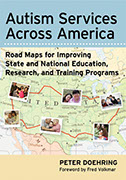Restructuring an ASD Preschool Program
While consultants from Drexel and the University of Pennsylvania had provided guidance to Elwyn's Seedlings program over many years, a series of parent concerns and administrative complaints suggested the benefits of significant restructuring in the fall of 2012. These consultants had recommended integrating new evidence-based practices into preschool programs, and were ready to provide a graduate student to assist in teacher training and coaching. There was specific interest in identifying and implementing the most effective elements of the STAR program and verbal behavior approaches.
I was brought in to weave these recommendations (and others I might identify) over a 10 month period in 2013, resulting in a broad and successful reorganization of Seedlings' programming (Dodge, Lamson, Downs, & Mandell, 2015).
 Established in 1852, Elwyn serves people with developmental disabilities across the mid-Atlantic region and in California. It is now the sole contracted provider for early intervention services for the School District of Philadelphia. While Elwyn provides the majority of services through subcontracts with other providers, the Seedlings Early Care and Education Center is Elwyn's flagship school for preschoolers with ASD.
Established in 1852, Elwyn serves people with developmental disabilities across the mid-Atlantic region and in California. It is now the sole contracted provider for early intervention services for the School District of Philadelphia. While Elwyn provides the majority of services through subcontracts with other providers, the Seedlings Early Care and Education Center is Elwyn's flagship school for preschoolers with ASD.
Key elements
Integrating ABA and Developmental Approaches into a new classroom model
For many years, Seedlings had operated one set of classrooms based on a more traditional, developmental model, and a second set relying exclusively on a model of early intensive behavioral intervention. These classrooms operated independently, with no cross-fertilization.
I worked closely with teachers, specialists, coaches, and school administration to create and then to implement a model that integrated a broader range of ABA-based techniques drawn from the STAR program into a flexible schedule that carefully balanced opportunities for intensive individual teaching and structured small- and large-group instruction, introduced more systematic assessment, and increased the use of evidence-based practices for promoting social and communication skills. By adapting and translating existing classroom practices into STAR and VB language, in coordination with coaching.
Troubleshooting day-to-day gaps in programming and support
I identified and implemented other changes to smooth day-to-day classroom operations. For example, I revised and helped to implement weekly classroom team meetings to increase problem solving at the classroom level, and monthly staff meetings to ensure timely dissemination and discussion of pending program changes. I also helped to revise staffing allocation to ensure that staffing ratios in the classrooms remained more consistent across the day to compensate the need for lunch breaks, classroom planning time, and other activities, and reduce behavioral triggers associated with drops in support.
Creating a professional development program including roles for specialists and coaching
Prior to the full implementation of the new classroom model, I also helped to revise and to begin to deliver their professional development program. This included new workshops on these new techniques and classroom schedules, and a proposed schedule for coaching and implementation checks.
As the new classroom model described above was under development, I helped Elwyn to re-define job descriptions to increase support to teachers. This included new job descriptions for behavior specialists to clarify their role in responding to teacher's concerns, and interviewing new specialists for these positions. I also helped to create a second tier of teacher assistant, to recognize assistants who had shown special initiative, to enlist them in helping to coach other assistants during their initial training, and perhaps reduce staff turnover.
Co-leadership invests in intensive program change in anticipation of a new Director
I had originally been invited to assume leadership of Seedlings. I proposed instead a model of interim co-leadership, in which I directly and immediately addressed pressing concerns in consultation with Elwyn leaders while a new leadership and staffing structure was defined, and then a permanent Director was hired.
During my tenure, I worked with Elwyn leadership to review practices and expectations regarding the design of IEP recommendations, and the allocation and tracking of specialists, in direct response to specific parent concerns that had previously required compensatory education. I formally and informally surveyed staff and parents to assess areas of strength and opportunity for improvement, and integrated feedback into the recommendations listed here. In the light of parent concerns and in response to survey findings, I also promoted an expansion of the role of Parent Partners (paid part-time positions created to help parents of Seedlings graduates and current students to assume a greater role in guiding new parents and advising the program). Finally, I drafted new job descriptions for he Director and Assistant Director that assured the experience and allocated the supervision needed to support the program changes detailed above, and then participated in interviews to hire new leaders. During the subsequent transition, I completed the shift to adopt the new classroom model before transferring all responsibilities onto the new leaders.
Outlining other steps for future program improvement and expansion
Prior to my departure, I presented a detailed plan for the next possible phases of program development. This focused on incrementally adding community-based classrooms to simultaneously address a number of issues, namely the need to increase overall capacity to eliminate logjams that risked introducing delays in initiating classroom-based services and to create a continuum of placements that could put students on the path to full integration upon their graduation" to kindergarten. These recommendations included a timeline that took into account the need to hire and train more staff, and shift more experienced staff into a mentoring role at community-based sites. These recommendations were based an an assessment of enrollment patterns that suggested a likely growth in referrals, and the need for a longer runway when launching new sites.
Related Content
On this site
 There is no natural pipeline to create new leaders with the training and experience needed to undertake comprehensive program development
There is no natural pipeline to create new leaders with the training and experience needed to undertake comprehensive program development
Every program with which I have worked has over-estimated its ability to recruit leaders of the right caliber. This leadership should include specific experience in delivering services, designing and implementing programs of training, understanding and building partnerships with agencies across health and education, identifying research and policy gaps and opportunities, and program planning and evaluation. Leadership experience that includes people with ASD or related conditions, and that spans different disciplines and agencies is especially valuable, because of the unique characteristics of these populations and settings. In a surprising number of university- or hospital-based demonstration projects, key clinical and program leadership responsibilities are assigned to individuals who may have never actually worked in or led a community-based program, collaborated closely with other disciplines in designing programs or delivering services, or even had training in delivering clinical or educational services. Except for programs in educational leadership, there are very few training programs that offer this kind of guidance. My solution in the case of Seedlings - to act as a co-leader in leading important changes during a leadership transition - helped to maintain the momentum for change without overloading new leaders.
 Optimize the amount and type of staffing support needed by creating a schedule that carefully maps activities by intensity and expertise required
Optimize the amount and type of staffing support needed by creating a schedule that carefully maps activities by intensity and expertise required
I extended a previous lesson about the importance of establishing the right level of treatment intensity, by adjusting schedules across classrooms to utilize assistants who would "float" across classrooms to provide additional support as needed according to IEP goals. Floating assistants were also selected to be able to provide coaching to less experienced assistants, and to watch for drift across different classrooms. This mapping of activities also addressed longstanding issues associated with drops in support that arose when staff took breaks. Finally, this mapping was pivotal in justifying the levels of support requested.
My Presentations and Publications
X
